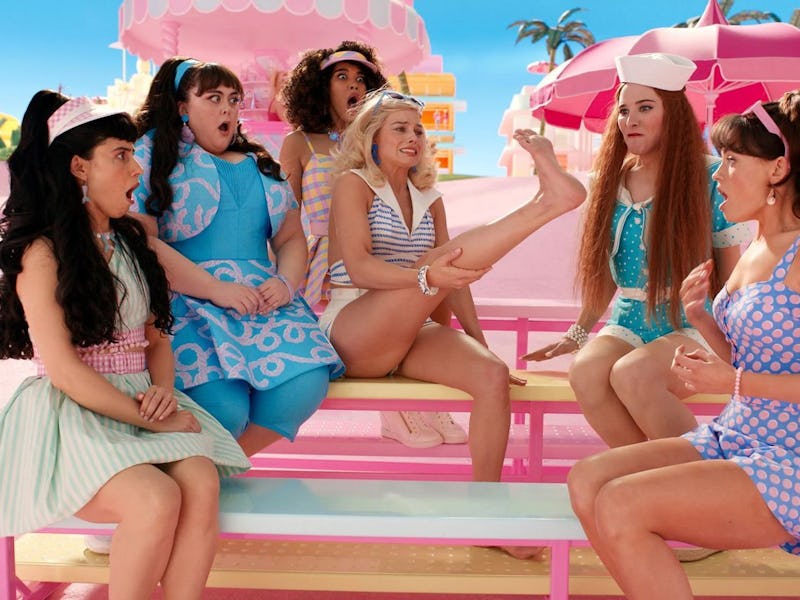The Best Scene in Barbie Would Be a Medical Nightmare in Real Life
This Barbie has hammer toes and bunions.

One of the most iconic shots in Greta Gerwig’s Barbie is of our heroine simply removing her shoes. (Don’t worry, this is all in the trailer. It’s not really a spoiler.) Barbie daintily steps out of pink heels, but her feet retain the tiptoe shape just like a real Barbie doll’s. When trouble arrives, it’s in the form of a foot flush with the ground. Barbie’s perpetually lifted heels have suddenly dropped, and that’s how everyone knows something’s amiss.
Further underscoring the doll-human dichotomy, Weird Barbie (Kate McKinnon) presents Barbie with a blue pill/red pill choice in the form of a high heel or Birkenstocks. Of course Barbie dolls aren’t made for flats! How can they have it all if they’re not literally balancing their body at all times?
So what would happen if we all walked like Barbie dolls, in a constant state of trying to reach something on the high shelf? A lifetime of tiptoe, it turns out, is no good for anyone.
While flat feet spell chaos for Barbie, constant toe-walking would destroy a mortal human body. Thankfully, Margot Robbie only had a few shots balancing on tiptoe without the auxiliary help of a high heel. If she’d had to spend weeks walking like Barbie, it would’ve taken a toll on her.
The Barbie foot
Walking like Barbie adjusts the entire body.
First, it throws off our center of gravity. Toe-walking shifts us forward and the toes grip at the ground. Humans are meant to use their whole foot, not just the forefoot. This footstep puts the walker at a much higher risk for falling according to Beth Gusenoff, a podiatric surgeon and professor of plastic surgery at the University of Pittsburgh.
“The muscles work in a symphony of balance,” Gusenoff tells Inverse. Walking on toes nonstop means some muscles will pull harder, which can change the shape of our bones. In particular, the leg’s front muscles overcompensate for the constantly tightened Achilles.
This gait also recruits the knee to do the ankle’s job. With the leg locked out from the knees to the toes, the ankle offers no support for shock absorption. The knee, which is basically a hinge, is at greater risk for moving off track. Without that shock absorption, the back also suffers. “You have all these discs in your back and if there's no shock absorption, the discs are going to wear down and you get inflammation in the back,” Gusenoff says.
These effects travel all the way up into the hip flexors, which also tighten. Then, the lower back can develop an exaggerated inward curve in a condition called lordosis. The core muscles, however, would weaken according to Julia Draoui, a pediatric physical therapist at the University of California, Los Angeles Health Rehabilitation Center.
“The tummy muscles would be weaker because they're leaning forward,” Draoui tells Inverse. “They're resting on their ligaments versus using their abdominal muscles, like we do when we walk heel-toe.”
Life on tiptoe
So, what would years of walking like Barbie do to someone?
“It's just a terrible cascade of events,” Gusenoff says. She says this person probably wouldn’t be able to lower their heels all the way to the ground from a shortened Achilles tendon and calf muscles. Those muscles, however, would be visibly sculpted if that’s any consolation.
Her bones would also literally change shape. The toes would develop knobby, arthritic knuckles. Gusenoff mentions conditions like “hammertoe” and “claw toe,” both of which are about as uncomfortable as they sound. Years of gripping the ground inflame the toe joints and wear down the protective cartilage between bones. Muscles pulling in unnaturally tight ways “ultimately change the shape of the bones,” she says.
Her feet could also develop a neuroma, in which a nerve gets enlarged and stuck in the flexed position. “So your feet are burning, your nerve is stuck in there,” Gusenoff describes.
Her knees can develop chondromalacia, or erosion of cartilage under the knee cap, which can result in pain inside the knee. “You can start to develop bone against bone,” Gusenoff says. Thick calluses and corns also bloom on these hardworking feet.
A life in high heels isn’t much better for us. Gusenoff says she’s seen patients who can’t lower their heels all the way to the ground after decades of wearing heels. Still, Draoui says that at least high-heeled shoes increase a step’s surface area, so you’re not concentrating all your weight on your toes.
In real life, it’s not just heels or Birkenstocks all the time. Our bodies literally and figuratively crave balance. Even though Barbie initially freaks out at her flat feet, it’s clear that this change is better in the long run. Even a small shift like balancing on our toes throws off everything else.
“The foot bone’s connected to the head bone,” Gusenoff tells Inverse. “It's going to start to have consequences all the way up the body.”
This article was originally published on